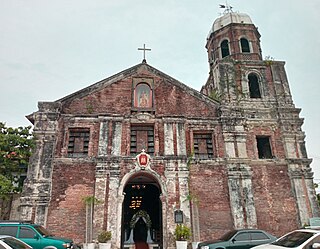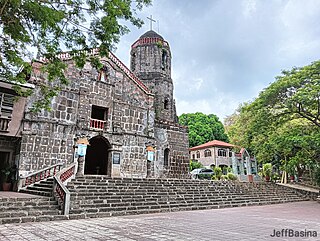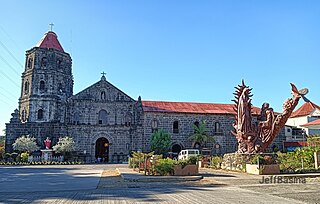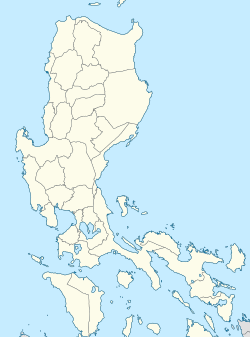
Nagcarlan, officially termed as the "Municipality of Nagcarlan", is a 2nd class municipality in the province of Laguna, Philippines. According to the 2020 census, it has a population of 64,866 people.

Pila, officially the Municipality of Pila, is a 3rd class municipality in the province of Laguna, Philippines. According to the 2020 census, it has a population of 54,613 people.

Morong, officially the Municipality of Morong, is a 2nd class municipality located in the province of Rizal, Philippines. As per the 2020 census, Morong has a population of 71,151 people.

Pililla, officially the Municipality of Pililla, is a 1st class municipality in the province of Rizal, Philippines. According to the 2020 census, it has a population of 71,535 people. It is surrounded by farms, small mountains, plains, and trees. Pililla is known as the Green Field Municipality of Rizal.
Miguel Juan de Plasencia was a Spanish friar of the Franciscan Order. He was among the first group of Franciscan missionaries who arrived in the Philippines on 2 July 1578.

The Diocesan Shrine and Parish of Saint Mary Magdalene, commonly known as Kawit Church, is the parish church of the municipality of Kawit, Cavite in the Philippines. It is under the jurisdiction of the Diocese of Imus. The Roman Catholic church is one of the oldest churches in the Philippines, construction of the present church was started in 1737. The church, named after Jesus' disciple Mary Magdalene, was last restored in 1990 by the citizens of Kawit.

Saint Francis of Assisi Parish Church, also known as the Diocesan Shrine of Santo Cristo de Burgos and commonly known as Sariaya Church, is a Roman Catholic church in Sariaya, Quezon, Philippines. It is under the jurisdiction of the Diocese of Lucena. Based on the historical marker of St. Francis of Assisi Church, the first structure was constructed in 1599. The second church was built in 1605 but was replaced by a third church in 1641. In 1703, the town was transferred to Lumangbayan but the earthquakes and floods of 1743 destroyed the church and the town caused the people to transfer to the present site. The present church was built in 1748 during the term of two Spanish friars, namely Fr. Martin de Talavera and Fr. Joaquin Alapont.

The Diocesan Shrine and Parish of Saint Joseph, commonly known as Baras Church, is a Roman Catholic church located in Baras, Rizal, Philippines, where the miraculous centuries-old image of San Jose de Baras is enshrined. It is under the jurisdiction of the Diocese of Antipolo. The church is known to be the oldest parish dedicated to Saint Joseph in the Southern Tagalog Region.

Saint John the Baptist Parish Church, commonly known as Calamba Church, is the oldest Roman Catholic church in Calamba, Laguna, Philippines under the Diocese of San Pablo. It is located adjacent to Rizal Shrine and is known as the christening site of José Rizal.

Saint Jerome Parish Church, commonly known as Morong Church, is a Roman Catholic church located in Morong, Rizal, Philippines. It is under the jurisdiction of the Diocese of Antipolo. The church was built during the Spanish period in the country, with stones from a hill called Kay Ngaya; lime from the stones of the mountain Kay Maputi; and sand and gravel from Morong River.

San Ildefonso de Toledo Parish Church, commonly known as Tanay Church, is a Roman Catholic church located in the town of Tanay, Rizal in the Philippines. It is under the jurisdiction of the Diocese of Antipolo. The construction of the present church was begun in 1773 and was completed after ten years in 1783. In 2001, it was declared as a National Cultural Treasure Church by the National Commission for Culture and the Arts. It is also among the seven Jubilee churches of the Diocese of Antipolo.

The National Shrine and Parish of San Antonio de Padua, commonly known as the Church of Pila, is a Roman Catholic national shrine dedicated to Saint Anthony of Padua in the Philippines in 1578 and the first Antonine parish church in the Philippines in 1581 and probably in Asia. It is under the jurisdiction of the Diocese of San Pablo. In 1606 the Franciscans set up the second printing press of the Philippines under the supervision of Tomás Pinpín and Domingo Loag. Its titular is Anthony of Padua, whose feast is celebrated every June 13.

Saint Gregory the Great Parish Church, commonly known as Majayjay Church, is one of the oldest Roman Catholic churches in the Philippines located in the municipality of Majayjay in Laguna. It is under the jurisdiction of the Diocese of San Pablo. The church is recognized by the National Museum as a National Cultural Treasure.

Saint James the Apostle Parish Church, commonly known as the Church of Paete, is the only Roman Catholic church in Paete, Laguna, Philippines. Its patron saint is James the Apostle and his feast is celebrated every July 25. It is under the jurisdiction of the Diocese of San Pablo. The church is known for its huge and exquisite collection of images depicting the Passion of Christ, its century-old paintings and wooden images of saints.

San Bartolome Apostol Parish Church, also known as Saint Bartholomew the Apostle Parish Church, is a Roman Catholic church in Nagcarlan, Laguna, Philippines. Its titular saint is Bartholomew and its feast day is celebrated every August 24. The church is under the jurisdiction of the Diocese of San Pablo.

San Sebastian Parish Church, commonly known as Lumban Church, is a Roman Catholic church in Lumban, Laguna, Philippines. Its titular is St. Sebastian and its feast is celebrated every January 20. It is under the jurisdiction of the Diocese of San Pablo. The first tabernacle outside Manila was inaugurated in Lumban including the first Eucharistic Procession outside of Manila. The Franciscans established the first School for Church Music in the country in this town under Juan de Santa Maria. Today, the church is under the pastoral care of the Clerical Congregation of the Missionaries of Faith.

Our Lady of Guadalupe Parish Church, designated as the Diocesan Shrine of Our Lady of Guadalupe, of the Diocese of San Pablo, is the only Roman Catholic church in Pagsanjan, Laguna, Philippines. It the oldest church in the country under the patronage of Our Lady of Guadalupe, whose image was a gift from Mexico.

Saint Louis Bishop Parish Church, also known as San Luis Obispo de Tolosa Parish Church, Saint Louis of Toulouse Parish Church and proposed Diocesan Shrine of San Isidro Labrador, commonly known as Lucban Church, is a Roman Catholic parish church located in Lucban, Quezon, Philippines under the supervision of the Diocese of Lucena. Its titular is Saint Louis of Tojk lang ituh

The Basilica Minore de San Pedro Bautista, also known as the San Francisco del Monte Church and alternatively as Santuario de San Pedro Bautista, is a minor basilica and parish church in the San Francisco del Monte district of Quezon City, Philippines. It is one of the oldest churches in the country and the oldest in the city, having been founded in 1590. The church is dedicated to its founder Padre Pedro Bautista, a Spanish missionary from Ávila, Spain, one of the 26 Christians martyred in Japan in 1597.





























